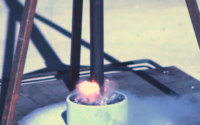Illicit Labs, Air Monitoring & More!
Todd Burton
When I started on the Hazmat team in San Diego in 1999, Meth Labs were still going strong down in the Southwest. We used to see a lot of Red Phosphorous (Red-P) methods down here; it’s funny how drug manufacturing methods are regional. It seems like one cook learns from the next and that method dominates the area. Meth was popular along with Cocaine and Ecstasy in the early 2000’s. They used to use good old R-12 refrigerant as a solvent for meth. I remember opening a small (10 gal) orange drum in the backcountry mountains on a hot day. My training officer at the time was all caught up in bashing everything on the scene, upon opening the drum I got a nice burst of pressure and spray of R-12. Nice. Well, I’m still here to write about it but hopefully you have a better training officer than I did.
The thing with drug manufacturing is that it is always changing and it’s hard to keep up with current methods. It’s always a good idea to work closely with your DEA contacts or specialized teams to gain that much needed knowledge that transforms into safety protocols and correct mitigation measures. I think one of my attractions to drug lab manufacturing calls is the challenge.
There are so many types of drugs, explosives, biological agents and more that can be made in a clandestine lab. I remember a call back in 2007 at an apartment complex. Both dumpsters were filled with chemicals and glassware. As we started to segregate chemicals by hazard class, we started to scratch our heads as we were finding some chemicals that could be used to make explosives. It took some dumpster diving and research to figure out what they were making, Ecstasy. That was one of those moments where you go, “Crap, I need to figure out how can we do this better and faster?” I decided to work with the DEA and Bomb Squad to identify all precursors for various narcotics and explosives, put them in a chart (Figure 1) that could be used on scene.

When you start to think about how to ID a lab, a lot of it has to do with KEY precursors and equipment/processes. Those KEY precursors can lead you to the right lab quickly, but don’t jump to conclusions until you have waded through all the crap, sometimes literally. Thankfully, there are some advanced instruments and databases like Chemical Companion
https://www.chemicalcompanion.org/ (From Dr. Baxter and Crew) that can do that for you quickly. As you can see from the CLAN LAB ID chart meth, Ecstasy, MDA, THC A, PCP, LSD, GHB, Cocaine, Fentanyl, DMT, Mushrooms, Steroids, and all the explosives can be a boat load of stuff to figure out. We have used this chart on POLY LABS (Making drugs & explosives) and have filled out 60% of the chart, insane. But let’s take a left and go down THC lane.

THC Extraction
I have never been to a METH LAB EXPLOSION like you see in the movies. 95% of labs are in static mode when you get there, but this changed with THC extraction/concentration. My first LAB EXPLOSION was in 2013. An extended stay hotel (Figure 2) https://abc7.com/hash-oil-weed-pot-marijuana/60344/had an explosion in one of the units that blew apart the adjacent units. En route, I was thinking to myself, this does not add up. By this time, I had done a lot of labs and the closest thing to a lab explosion was a Nazi Lab method (Ammonia) in a pressure cooker that blew up.
Back to the THC explosion. As we walked up to the extended stay hotel, all the windows were blown out, glass everywhere, blood all over the walkway with hair and other human pieces. The resident ran down the hallway to another room and got in the shower. As we entered the room to monitor there were a lot of small cans. He was OPEN BLASTING butane in a very small space. Lit a cigarette and K’BOOM. The fire ball consumed most of the Butane and the residual must have evaporated as we didn’t get much on the 4-gas, calibrated to Hexane, monitoring around my shins (remember this) but we found a lot of Honey Oil. That was the start of a journey in THC extraction for me.

Let’s take a look at the Marijuana plant. You have male and female plants (Figure 3). You want the female plants that produce the large resin-secreting flowers that are trimmed down to round or pointed buds. That shiny, sticky icky are made up of TRICOMES (Figure 4). The resin material where the Delta 9 resides. Ever heard of the term, like dissolves like? Non-polar substances like resin need a non-polar solvent to pull the resins off the flowers (more on alcohol extraction later). This works best with non-polar solvents like Butane, Propane and Isobutane. That’s typically what you find in one of those cans (Figure 5) they used for blasting.


There are many methods to extract the Trichomes. You can fly under the radar with Ice Water Extraction, Dry Ice, Liquid Nitrogen and Resin Press. Lots more out there but let’s stick to the hazardous stuff. I think most of you know about OPEN BLASTING. This is the most hazardous way to extract the Trichomes. You basically pack a tube with shake (trimmings from the plant as it has Trichomes all over the plant), push your pressurized solvent through a small opening on one side and it expels from the other through multiple holes or a coffee filter into a Pyrex dish. NOTE: Some of these extractors or small tubes have been mis-identified as pipe bombs. The advice to give the bomb squad is to look for ONE hole on one end and multiple holes or open end at the other side. Once the butane has hijacked the Trichomes, is pulling them through the column and they land in the dish, the butane (Mix) must evaporate leaving the Trichomes behind. Thus, the gas is liberated in the immediate area. Any open flame or static discharge equals peeled skin. We did some studies on how we could ignite the flammable gases and were surprised on the results being only open flames and static discharge (Disclaimer, you may get ignition with other sources, but we did not).
You can see many of the YouTube videos here on my YouTube channel, Hazmatter7 Butane Hash Oil Ignition Sources . Once the Butane evaporates, they have a semi-usable product depending on their quality control. They may choose to do a vacuum purge and reduce atmospheric pressure to allow the Butane to escape resin matrix reducing harm to the user.

That’s basically it for open blasting but I would be remiss if I did not tell you the most important lesson, I learned during our THC study: monitoring for flammable gases. I thought I was good at what I was doing, 13 years or so on the team. We expelled 4 cans in a 10x10x12′ space. Let it rest for 2 minutes. We had 4-gas monitors at 12, 24 & 36″ in that room. We ignited the gas with a taser on the floor (Figure 6). That flame exploded out of the room with such force it shook the entire building! Thankfully we didn’t cause any damage, except for many of our observers needing to check their pants!
Remember I said above I monitored at my knee, or so, in these labs. I didn’t have a good mental picture of where this gas goes. The properties state 2.5 times heavier that air, ok somewhere below my knee. The 4-gas monitor at 12″ was at 3% Lower Explosive Limit (LEL) when that explosion occurred. Got your attention?
I should have all your attention if you are still reading this. You must monitor within 1″ of the ground!!! It pancakes! You may get lucky (Well not really) and kick it up into your monitor intake. This was an eye opener for me as this stuff spreads out and lays so low. We advise you to evacuate as soon as you are getting low LEL readings. We can talk about other methods and exploding refrigerators, winterization, closed loop systems and bit more later. For now, keep the 4-gas very low.
The manufactures have moved to closed loop systems that keeps their skin on. The distillation processes of other Cannabinoids, Terpenes and Flavonoids is really mind blowing!



